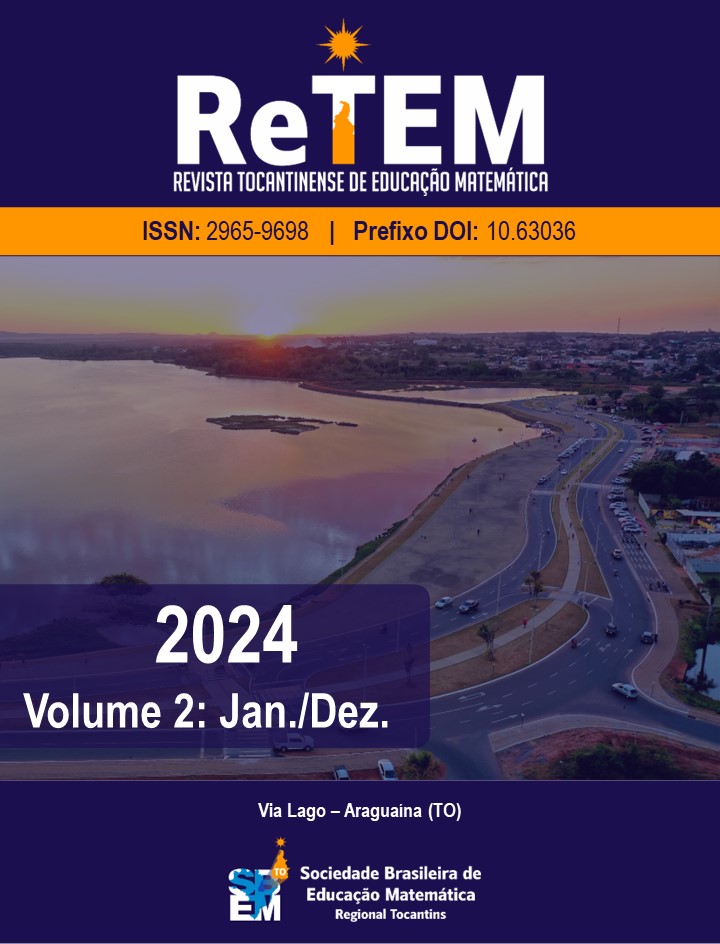INVESTIGATING CONNECTIONS BETWEEN GEOMETRIC KNOWLEDGE PRESENT IN TOURIST AND HISTORIC ATTRACTIONS OF SANTARÉM
DOI:
10.63036/ReTEM.2965-9698.2024.v2.49Keywords:
Teaching, Geometric knowledge, Tourist Attractions, Historic buildings, Investigative connectionsAbstract
The objective of this work is to present the development of an action, in the form of a set of activities, involving different actors linked to the José de Alencar school: basic education students, preceptors, and residents, in which investigations were carried out associated with geometric knowledge studied in basic education and their relationship, based on the identification of geometric shapes, in tourist attractions and historic buildings located in the city of Santarém, state of Pará. The method adopted was that of participant observation, in which the students, guided by the preceptor and resident, conducted sketches and observations associated with the structures and facades of some historic buildings, aiming to discuss and find concepts and geometric representations associated with them. Thus, with the development of activities, it was possible to set up a channel of dialogue between the elaboration and production of situations and experiences of articulation between knowledge of basic mathematics and practical aspects associated with Santarém society.
Downloads
Metrics
References
BRASIL. Ministério da Educação. Base Nacional Comum Curricular. Brasília, 2018.
CRESWELL, John W. Investigação qualitativa e projeto de pesquisa: escolhendo entre cinco abordagens. 3ª. ed. Ed.: Penso, 2014.
FARIA, J.B.; PEREIRA, J.E. Residência pedagógica: afinal, o que é isso? R. Edu. Púb. Cuiabá, v.28, n.68, mai/ago 2019. DOI: https://doi.org/10.29286/rep.v28i68.8393
FREIRE, P. Pedagogia da Autonomia – Saberes Necessários à Prática Educativa. São Paulo: Paz e Terra, 2002.
FREIRE, P. Pedagogia da indignação: cartas pedagógicas e outros escritos. São Paulo: Editora UNESP, 2000. DOI: https://doi.org/10.1590/S1414-32832001000100016
FREIRE, P. Pedagogia do oprimido. 65ª edição. Rio de Janeiro: Paz e Terra, 2018.
FREITAS, M.C.; FREITAS, B.M.; ALMEIDA D.M. Residência pedagógica e sua contribuição na formação docente. Ensino e Perspectivas. v.1, n.2, p.1-12, 2020.
GIL, A. C. Métodos e Técnicas de Pesquisa Social. 5 ed. São Paulo: Atlas, 1999.
LORENZATO, S. A. Por que não ensinar geometria? In: A Educação Matemática em Revista. Blumenau: SBEM, ano III, n. 4, 1995.
MONTEIRO, N.S.; ALMEIDA, N.I.S.; SOUSA, E.S.; MAFRA, J.R. O ensino de geometria em escolas municipais de uma cidade paraense: o que aponta um grupo de professores? Comunicação Científica. In: I Encontro Nacional Residência Pedagógica Matemática. Anais do I ENRPM Universidade Federal de Santa Maria. 2023.
NASCIMENTO K.; FERNANDES, M.; MIRANDA R. Arquitetura e Geometria: reflexos na construção acerca do patrimônio histórico da cidade de Santarém-PA. Santarém: 2023.
SANTANA, F.C.; BARBOSA J.C. Dispositivo formativo da residência pedagógica: ataques, lutas e resistências. Revista Brasileira de Educação. n.25. 2020. Disponível em: https://www.scielo.br/j/rbedu/a/kcHJszJzt8zGSyxmSRpmSYq/?lang=pt DOI: https://doi.org/10.1590/s1413-24782020250065
SILVA, P. H. C; SILVA, R. A.; SÁ, A. R.; SANTOS, D. C. P. Ferramentas didáticas de Geometria no ensino fundamental I. Caderno Aplicação: pesquisa e reflexão em educação básica. Porto Alegre, v. 35, n. 1, 2022. DOI: https://doi.org/10.22456/2595-4377.121563
VIANNA, Heraldo Marelim. Pesquisa em educação: a educação. Brasília: Plano Editora, 2003.
ZEICHNER, K. M. Políticas de formação de professores nos Estados Unidos: Como e por que elas afetam vários países no mundo. Belo Horizonte: Autêntica, 2013.
Downloads
Published
Métricas
Visualizações do artigo: 223 PDF (Português (Brasil)) downloads: 164
How to Cite
Issue
Section
License
Copyright (c) 2024 José Ricardo e Souza Mafra, Aldemisa de Jesus Oliveira, Nicole de Sousa Monteiro

This work is licensed under a Creative Commons Attribution-NonCommercial 4.0 International License.
Licenciado sob a Licença Creative Commons Attribution-NonCommercial 4.0 International (CC BY-NC 4.0). Esta licença permite compartilhar, copiar, redistribuir o manuscrito em qualquer meio ou formato. Além disso, permite adaptar, remixar, transformar e construir sobre o material, desde que seja atribuído o devido crédito de autoria e publicação inicial neste periódico.


 Português (Brasil)
Português (Brasil)
 English
English
 Español (España)
Español (España)


























